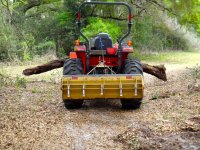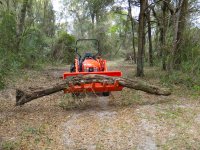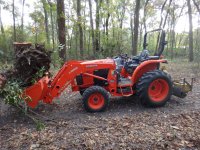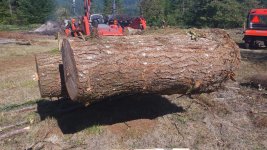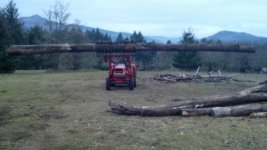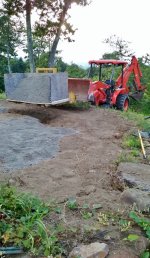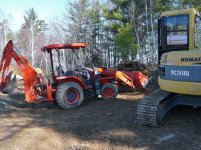jeff9366
Super Star Member
- Joined
- Jan 14, 2011
- Messages
- 12,787
- Tractor
- Kubota Tractor Loader L3560 HST+ ~~~~~~~~~~~~~ 3,700 pounds bare tractor, 5,400 pounds operating weight, 37 horsepower
I believe your 14.9 x 26 R1 tires have a 3,000 pound load rating vs 4400 pound rating on a typical 17.5 x 24 R4 tire. Tire companies state that liquid ballast must be included in the load. Not sure what your weight might be with loaded tires and backhoe. I've typically seen backhoe on R4 equipped tractors due to the higher load capacity. There are many caveats in the load inflation tables. For instance while stationary the tire can be overloaded to 135% overload (235% of rating). At 2.5 mph that drops to 100% overload and continues to drop to rated capacity at standard speed (20 mph).
Variations in recommendations are to be expected here.
Personally, as you have R1/ag tires, 3/4 filled with liquid, I think 800 pounds of Three Point Hitch counterbalance should be ample, ample for loader work. Count me in the population that attempts to minimize soil compaction while getting whatever job done.
Considering the tasks you have outlined in Post #11, with liquid filled rear tires I recommend you shop for a Box Blade or Rollover Box Blade of 700 pounds to 800 pounds weight. This assumes you will NOT have iron wheel weights.
"I am planning on using the tractor to dig out for a garage and a couple small ag sheds, dig a 3'x3'x400' ditch, install 80' of 24" pipe, 500 ft of water line, set 200- 6" posts, install 4000' of fence, cut and bale 5 acres for hay, keep 5 acres clear, seed and fertilize, keep up 1300' of gravel drive, and perform normal maintenance on a small farm."
(Lordy, I cannot imagine the cost per pound to cut, dry and bale five acres of hay with own equipment!)
You have not clarified whether or not you are considering iron wheel weights.
I have air-filled R4/industrial tires and LA805 loader on my L3560. I pull a Ford two-bottom, 12" plow and a Tufline Disc Harrow with 20" diameter pans weighing 915 pounds regularly without traction issues, over never-mud Florida sandy-loam.
For loader work I use a 700 pound, 60" wide everytfhingattachments.com Cultipacker for Three Point Hitch counterbalance most frequently.
Your loaded R1/ag tires will be 50% (estimate) more "grippy" on flat land than my air-filled R4/industrial tires.
Attachments
Last edited:
